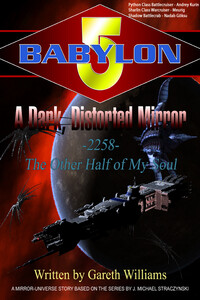Gareth D. Williams
Prologue: The Missing Year
2261 was the year the war ended. 2262 was the year the peace began. But for some people the difference between peace and war is very small indeed. Decisions made in wartime look harder in the cold light of day, and the greater the light shining in the galaxy, the greater the shadows cast by it. 2261 was the year the war ended. 2263 was the year the peace fell apart. 2262 was the year in between. The year the dream was born.
The Shadow War ended in 2261, as did all the other wars that had been raging in the galaxy at the time — a result, directly or indirectly, of the Shadows and their involvement with the younger races. The longstanding conflict between the Narn and the Centauri that had resumed in 2259 came to a close with the Kazomi Treaty. The Human / Minbari War formally ended with both races joining the United Alliance. The Human civil war also formally ended with that event, as the new Proxima Government entered the Alliance.
It was a time of relative optimism, at least briefly. After all the wars and bloodshed of the preceding years, a period of peace was welcomed by almost everyone. There were of course numerous skirmishes, raids and attempts to hunt down those wanted for various war crimes during the previous decade, but except for the Drazi Conflict (q. v., chapter 7) 2262 was a year of peace.
It is easy to overlook those twelve months in the light of the events that followed, but the collapse of the peace and even of the Alliance itself cannot be considered in isolation. The formation of the Alliance and the circumstances that gave it birth have already been studied, and the next volume will deal with its downfall. Now, however, the twelve months during which the Alliance effectively ruled the galaxy unchallenged will be examined.
Note: all dates given in this volume are Earth standard unless specifically stated otherwise.
GILLESPIE, E. (2293) The Light Ages. Chapter 1 of The Rise and Fall of the
United Alliance, the End of the Second Age and the Beginning of the Third,
vol. 3, 2262: The Missing Year. Ed: S. Barringer, G. Boshears, A. E.
Clements, D. G. Goldingay & M. G. Kerr.
* * *
The ultimate focus of 2262 was undoubtedly the building of the new centre of the Alliance: the space station called Babylon 5, a continuation, most probably, of Ha'Cormar'ah G'Kar's ultimately failed attempt at providing a central gathering place for those fighting the Shadows in 2260: the Babylon 4 space station, destroyed at the Battle of the Third Line.?
Babylon 5 was constructed in high spirits, with representatives from all the major races involved in the effort. While this was clearly used as a public relations spectacle — the sight of former enemies working together to create a home of peace was then a welcome one — practical necessities were also a concern. No one race had the resources to fund a station of that size and capacity on its own, and neither did the Alliance as a whole. There were many complaints about the vast resources needed to complete the station, seen by many as unnecessary given that Kazomi 7 was still perfectly capable of housing the Alliance Government and bureaucracy. However, others had more personal misgivings.?
? WILLIAMS, G. D. (2291) A Line in the Sand. Chapter 4 of The Rise and Fall of
the United Alliance, the End of the Second Age and the Beginning of the
Third, vol. 2, The Years of Battle. Ed: S. Barringer, G. Boshears, A. E.
Clements, D. G. Goldingay & M. G. Kerr.
? See also Learning at the Prophet's Feet, by L'Neer of Narn, and One Eye to the
Future by G'Dan (based on interviews with Commander Ta'Lon), for more
details concerning Ha'Cormar'ah G'Kar's personal feelings about the
construction of Babylon 5.
LAKER, A. (2293) A Shining Beacon in Space. Chapter 14 of The Rise and Fall of
the United Alliance, the End of the Second Age and the Beginning of the
Third, vol. 3, 2262: The Missing Year. Ed: S. Barringer, G. Boshears, A. E.
Clements, D. G. Goldingay & M. G. Kerr.
* * *
It would be a shining beacon in space, a dream given form, a place of peace in a galaxy that had known only war. It would be a symbol of the new age, an age which would at last no longer need to fear shadows.
And it would be called Babylon 5.
G'Kar said the name to himself softly. "Babylon Five." The name sounded right, somehow. Appropriate. He had tried to create a similar dream once before with Babylon 4, but that project had ended in fire and destruction and so many deaths. The cost had drained him, both financially and emotionally. After it had gone he had done…. so little, as if that station had been his greatest and only contribution to the future.











